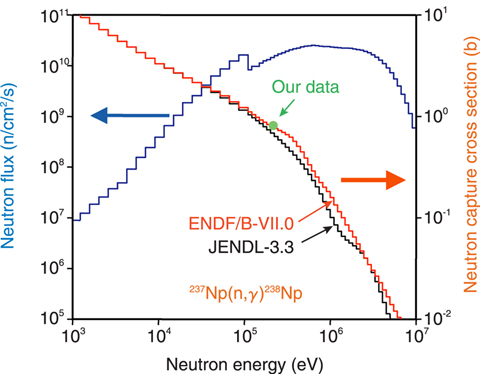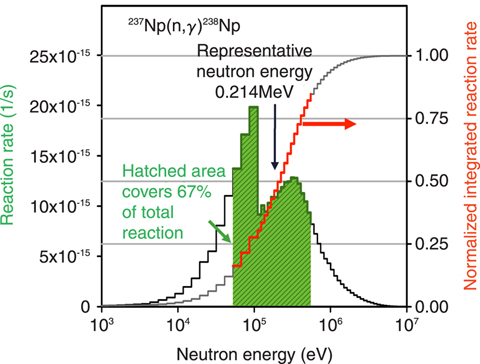
Fig.7-5 Neutron flux at the center core of the Yayoi reactor and the evaluated neutron capture cross section of 237Np in two libraries, JENDL-3.3 and ENDF/B-VII.0

Fig.7-6 Energy dependence of the reaction rate of 237Np and of normalized integrated reaction rate
Accurate data of the neutron cross sections of minor actinides (MA) such as Neptunium (Np), Americium (Am), and Curium (Cm) over a wide neutron energy range from thermal to MeV regions are required for development of innovative nuclear systems capable of nuclear transmutation of minor actinides.
However, there is an apparent discrepancy among current nuclear data on MA's. As an example, the neutron capture cross sections of 237Np of JENDL-3.3 and ENDF/B-VII.0 are shown in Fig.7-5. There is a large gap above 100keV (105eV).
We have utilized the activation method to measure accurately the capture cross sections of MA using fast neutrons supplied by the Yayoi reactor. Since the neutron flux is very high at the reactor core in the fast neutron region, a small sample of the order of 0.1mg is sufficient. This fact is important to eliminate experimental difficulties inherent in measuring the capture cross sections of radioactive samples.
However, it is difficult to obtain point wise data by the activation method using fast reactor neutrons, since the Westcott convention established for thermal neutrons is not applicable. To overcome the problem, the new convention is proposed, in which the "representative neutron energy" is defined; the capture cross section corresponding to that energy can be determined. Fig.7-6 shows the energy dependence of the reaction rate of 237Np, and of the normalized value of the integrated reaction rate, which can be used to determine the representative neutron energy analytically.
Our data is plotted in Fig.7-5. It is shown that the activation method using fast reactor neutrons is a very powerful tool to determine neutron capture cross sections for fast neutrons. The developed activation method together with the time-of-flight method under development at the J-PARC MLF neutron-nucleus reaction instrument will be used to systematically and accurately determine the neutron capture cross sections of radioactive samples such as MA.